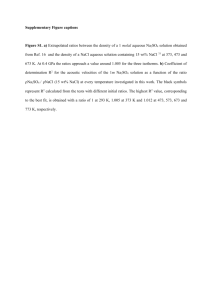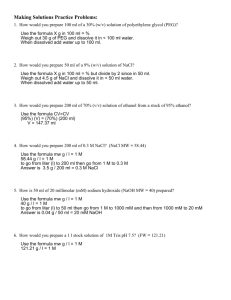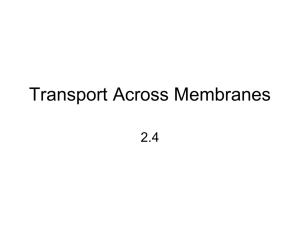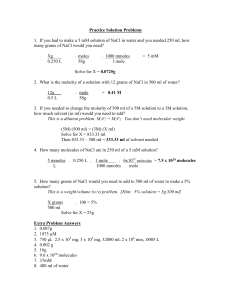Tonicity, Osmoticity, Osmolarity, & Osmolality
advertisement
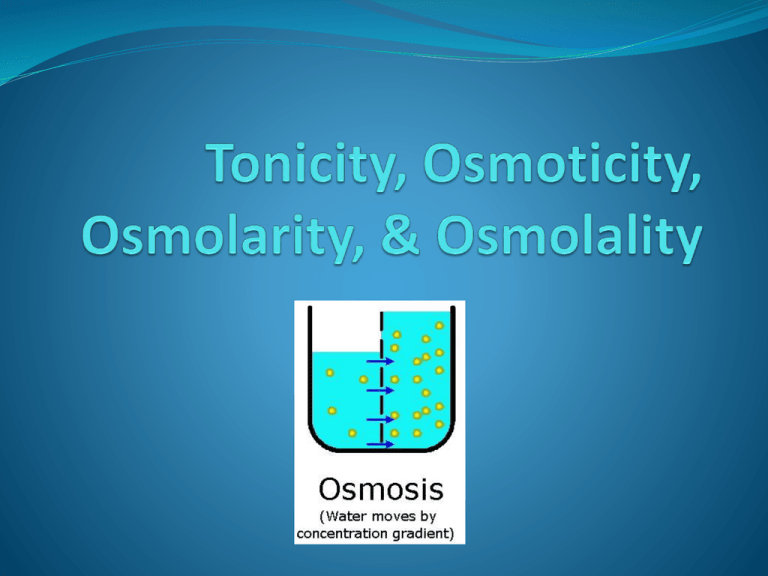
How to get an A and grasp this concept! Know the differences between osmosis and diffusion Know page 171 in your calculations book, backwards and forward Instead of “plugging and chugging” actually understand where the equations come from and what they are giving you Understand why this concept is important. You WILL see it again in other classes whether you realize it or not (i.e. major drug classes revolve around this concept, such as diuretics) How to get an A and grasp this concept! Understand the difference between hypertonic, hypotonic, and isotonic and how it affects cells Remember to double check your work. An eraser costs 10 cents, a mistake can cost you millions and your pharmacy license! Basic Concept: Osmosis and Diffusion Basic Concept: Osmosis and Diffusion Osmosis is the passage of WATER from an area of high concentration to an area of low concentration through a partially permeable membrane Diffusion is the passage of molecules from an area of high concentration to an area of lower concentration Basic Concept: Osmosis and Diffusion In the previous example, osmosis occurs because the membrane is NOT PERMEABLE to the sugar molecules but is permeable to the water. If there was a completely permeable membrane, the water would move to the left and the sugar molecules would move to the right until EQUAL concentrations of each were on both sides Basic Concept: Osmotic Pressure The pressure required to prevent solvent from passing through a semipermeable membrane from a region of higher concentration of solute to a region of lower concentration of solute. Osmosis and Diffusion: Application to real life What does all this have to do with pharmacy? Believe it or not, all cells are semi-permeable Thus, they allow some stuff to pass while inhibiting others from passing This occurs through various processes, such as active diffusion, passive diffusion, etc. The concept we need to understand is that cells will behave differently based on what solution they are in because water can move by way of osmosis Osmosis and Diffusion: Application to real life Say we have a human cell that contains 10% (THIS IS A CONCENTRATION) NaCl within its cell membrane. There are basically 3 different solutions we can place it in There are solutions that are more concentrated There are solutions that are less concentrated There are solutions that are the same concentration Osmosis and Diffusion: Application to real life If we placed the cell in the previous slide in a solution that contains the same concentration of NaCl then there would be no net movement of water because the cell is at “equlibrium” When this occurs, the solution is said to be isotonic Note that even though there is no net movement of water, water still goes back and forth Osmosis and Diffusion: Application to real life What would happen if we placed a cell with 20% NaCl in a solution that only had 10% NaCl? Osmosis and Diffusion: Application to real life In this situation, the cell is MORE CONCENTRATED with solute particles than the solution (i.e. the outside of the cell has more WATER per unit volume) Remember, water moves from an area of high concentration to low concentration Thus, water will move into the cell This type of solution is called Hypotonic Osmosis and Diffusion: Application to real life What if the solution contained a higher concentration of solute (NaCl)? Application to life: One step further Instead of a regular cell, let’s see what would happen with a red blood cell! Application to life: One step further When a red blood cell is placed in an isotonic solution nothing happens When a red blood cell is placed is a hypertonic solution the cell begins to shrink as water goes out of the cell, a process called CRENATION When a red blood cell is placed in a hypotonic solution the cell begins to swell and burst, a process called lysis (hemolysis) One more step further Knowing what you know now, explain what would happen in the following situations Applying 5% NaCl eyedrops to the eye given that the “concentration” of the eye is 0.9% Commercially available as Muro 128 ® eyedrops Swallowing mannitol which is a nonelectrolyte that behaves like NaCl and is impermeable to the intestines Hold your pee for a Wii®!!! Important Note Remember, osmotic pressure that is produced on either side of a membrane is related to the number of particles the solute produces, not just the concentration. i.e. A cell placed in a 10% solution of KCl will behave differently than a cell placed is a solution of 10% NaCl because of Osmolarity of the different molecules Explained in detail later Basic Concept: Electrolyte vs. Nonelectrolyte An electrolyte is a molecule that dissociates into solution and conducts current due to a charge on the molecule Examples include NaCl, KCl, etc. When an electrolyte is placed in a solution, it produces 1 Osmol for every particle that dissociates (assuming 1 molecular weight) NaCl Example A nonelectrolyte doesn’t dissociate when placed in solution Examples include Dextrose, Boric Acid, Mannitol When an electrolyte is placed in a solution, it only produces 1 Osmol (assuming 1 molecular weight) Dextrose Example Basic Concept: Molecular weight and other measures The molecular weight and the "electrolyte status” of a molecule gives us a bunch of information Know that 1 Osmol is the amount of a solute that will provide 1 Avagadro’s Number of particles Based on this information, we can deduce that if we have a solution of 1 molar dextrose and 1 molar NaCl that the NaCl solution would have more particles because it gives 2 Osmol per mole Understanding the differences between substances Suppose in the below diagram we had 58.5 g (1 mole) of NaCl on the left side of the semi-permeable membrane and on the right side we had 61.8 g (1 mole) of Boric acid Which way would the water move? Why? Understanding the differences between substances With only knowing the fact that NaCl is an electrolyte and Boric Acid is a nonelectrolyte and that we have 1 molecular weight of each we can tell that the NaCl side would have more particles Thus, water would move into the NaCl compartment Understanding the differences between substances Suppose in the below diagram we had 10% NaCl on the left side and 10% KCl on the right side (assume equal volume of solution on each side) Which way would the water move? Understanding the differences between substances In the example, we have to take into consideration the molecular weights and Osmolarity of the two substances. The MW of NaCl is 58.5 g which provides 2 Osmol, thus in a 10% solution we would only have 0.1709 moles or 0.3418 Osmol The MW of KCl is 75 g which provides 2 Osmol, thus in a 10% solution we would only have 0.1333 moles or 0.2666 Osmol Based on this we can see that there would be more particles on the NaCl side and thus water would move into the NaCl compartment Understanding the differences between substances Suppose we had 0.1 molar solutions of two different nonelectrolytes, say dextrose and boric acid, in the below diagram Which way would water move? Understanding the differences between substances Because there are an equal number of moles of two nonelectrolytes, and thus the same number of particles, the net movement of water will be zero! Homework! Look up NORMALITY and know how it would come into play in the above scenarios (i.e. 1N NaCl on one side and 1N KCl on one side) A side note on particle number How many Osmol would 1 mole of CaCl2 provide in solution? What’s the purpose of all this? The whole idea is to be able to make a solution that will either be isotonic, hypertonic, or hypotonic with body fluids in order to get the effects we want. For example, if we want to give someone fluid to prevent dehydration we want it to be isotonic with the blood so we won’t hurt the red blood cells. Or if we want to make someone have a bowel movement we want to make the inside of the intestines Hypertonic so water will come into the intestines and produce a bowel movement Colligative properties Colligative properties are properties of solutions that depend on the number of molecules in a given volume of solvent and not on the properties (e.g. size or mass) of the molecules There are 4 colligative properties: Boiling point, Freezing point, Vapor Pressure, and Osmotic Pressure To understand how each of these behave, let’s talk about salt. Colligative properties continued Thus, when we add salt to a pot of water 4 things happen: The vapor pressure goes down The osmotic pressure goes up The boiling points goes up The freezing point goes down To help you remember this, just keep in mind: Colligative properties continued Of the properties, we will be using the freezing point for class purposes When you add exactly 1 mole of a nonelectrolyte to water it brings the freezing point down to -1.86 degrees celcius What do you think would happen if we added 1 mole of an electrolyte? Would it bring it down even further (depress it) or raise it further? Colligative properties continued If we add an electrolyte, it will depress it even further depending on how much the molecule dissociates in solution (i.e. creates more particles) This brings us to the concept of the “i value” Is a proportionality constant that relates number of particles to freezing point depression We determine this value based on the assumption that electrolytes, with a few exceptions, dissociate at 80% in solution Colligative properties continued How to calculate NaCl Value How to calculate KCl Value How to calculate CaCl2 value Exceptions (Zinc Sulfate) The body’s freezing point Based on the concentration of different solutes in our blood and bodily fluids, it has been found that we will freeze at -0.52 degrees Celsius Walt-Disney! If we know that a 1 molar solution of NaCl freezes at 1.8 * -1.86 degrees Celsius then we can determine what molar solution of NaCl freezes at -0.52 degrees Celsius Thus, it will be isotonic with body fluids Equation number 1! o Mole in gL-1.= - 1.86 C*i o XgL-1. - 0.52 C Standard Calculations Now we are able to calculate what percent solution of different solutes are isotonic with bodily fluids NaCl Dextrose Boric Acid KNO3 Standard Calculations Note: There is a difference between something that is isotonic and isoosmotic! Isoosmotic => Same number of Osmoles Isotonic=> Physiological compatability Standard Calculations What’s the difference between 1 mole of NaCl and 1 mole of KCl? What’s the deal with Boric Acid? IS ISO-OSMOTIC WITH BOTH BLOOD & LACRIMAL FLUID Standard Calculations True or False: Everything that is isotonic is isoosmotic. True or False: Everything that is isoosmotic is isotonic. Methods for making something isotonic There are three different ways to calculate how to make something isotonic The “D” Method, or depression method The “E” Method, or equivalent method The “V” Method, or volume method The “D” Method You’re working in a compounding pharmacy when you receive the following prescription from Dr. Saber Samaan: Freezing Point “D”epression Explaination With the D method, you are seeing how much each drug required of the prescription depresses the freezing point towards -0.52 degrees celsius. You will then make up the difference with NaCl or whatever other agent the prescription calls for to make it isotonic! Freezing Point “D”epression The first step is to calculate how much NaCl would be needed to make the volume of the prescription isotonic! It’s a simple proportion from the 0.9% reference we already know If 0.9 grams will make 100 mL isotonic, how many grams will make 30 mL isotonic? FREEZING POINT “ D”EPRESSION Naphazoline HCl -1 247gL -1 0.2gL o = - 1.86 C*1.8 o -X C o - 0.0027 C FREEZING POINT “ D”EPRESSION ZnSO4 -1 288gL -1 2.5gL o = - 1.86 C*1.4 o -X C o 0.0226 C Total depression o 0.0027 C o +0.0226 C 0.0253 oC o = -0.52-(-0.0253) = 0.4947 C 270 mg Xmg o 0.52 C o 0.4947 C The “E”quivalent Method The “E” method is a littler different Here, we are basically seeing how much NaCl produces the same osmotic effect as 1 gram of the drug! In essence, we are “converting” the drugs in the prescription to its NaCl equivalent In order to do so we have to take into account the drugs i value and molecular weight The “E”quivalent Method The first step here is the same as the first step in the D method The “E”quivalent Method Mole of NaCl gL-1 * iDrug Mole of drug gL-1 * iNaCl The “E”quivalent Method -1 58.5gL *1.8 -1 247gL *1.8 = 0.2368 g NaCl The “E”quivalent Method Knowing this, we must now set up a proportion If 1 gram of Naphazoline HCl is equal to 0.2368 grams of NaCl, then 0.006 grams of Naphazoline is equal to X grams of NaCl? The “E”quivalent Method -1 58.5gL *1.4 -1 288gL *1.8 = 0.1579 The “E”quivalent Method Knowing this, we must now set up a proportion If 1 gram of Zinc Sulfate is equal to 0.1579 grams of NaCl, then 0.075 grams is equal to X grams of NaCl? The “E”quivalent Method The next step is to sum up the two quantities calculated and subtract them from step 1! The “V”olume Method The V method relies on the E value and involves a lot of proportions The purpose of this method is to determine how much water the drug should be dissolved in and then the excess volume of the prescription is made up with NSS The “V”olume Method -1 58.5gL *1.8 -1 247gL *1.8 = 0.2368 g NaCl 100 mL x mL 0.9gNaCl 0.2368gNaCl x mL = 26.32mL Dissolving 1 g of Naph.HCl in 26.32 mL of distilled water, the solution will be isotonic. 26.32mL 1 g N.HCl x mL 0.006 gN.HCl If you dissolve 6 mg of N.HCl in 0.16 of water, the sol. will be isotonic. 0.15792 mL The “V”olume Method -1 58.5gL *1.4 -1 288gL *1.8 = 0.1579 100 mL x mL 0.9gNaCl 0.1579gNaCl x mL = 17.5mL Dissolving 1 g of ZnSO4 in 17.5 mL of distilled water, the solution will be isotonic. 17.5mL x mL 1 g ZnSO4 0.075 g ZnSO4 1.31 mL If you dissolve 75 mg of ZnSO4 in 1.31 mL of H2O, the sol. will be isotonic. 0.1579 mL 1.3125 mL 1.4704mL Dissolve 6 mg of naph.HCl & 75 mg ZnSO4 in 1.47 mL water, and qs to 30 mL with isotonic 0.9% NaCl. *This is the easy part* Electryoltes Na & Cl are the most plentiful electrolytes in the body NORMAL HEALTHY HUMAN: Na 138-146 mMol.L-1 Cl 98-109 mMol.L-1 K 3.7-5.3 mMol.L-1 Ca 2.25-2.65 mMol.L-1 *Memorize this table, it will prove useful on the test and in other classes to come! Osmoticity: Application to real life Believe it or not, the simplest things in life all relate to everything we’ve been talking about Why do we become thirsty? Signs and Symptoms of Osmoticity Changes Normal 285 mOsmol kg-1 282-288 mOsmol kg-1 THIRSTY 294-298 mOsmol kg-1 DRY MUCOUS MEMBRANE:299-313 mOsmol kg-1 WEAKNESS, DOUGHY SKIN: 314-329 mOsmol kg-1 Once your plasma osmoticity >330 mOsmol/kg: Disorientation Orthasis Severe Weakness Fainting Coma Signs and Symptoms of Osmoticity Changes As your Osmoticity goes below normal range: Headache (275-261) Drowsiness (262-251) Cramps (250-233) Seizures & Coma (<230) Compensation Mechanisms What mechanisms does our body have in place to combat changes in plasma osmoticity? ADH SERUM OSMOLALITY 1.86 Na + BLOOD SUGAR + BUN +5 18 2.8 A QUIKY 2 Na + BLOOD SUGAR + BUN 20 THE QUICKEST 2 Na + 10 3 Serum Osmoticity: Homework Look up the signs and symptoms of dehydration Serum Osmoticity: Practical Application A patient comes into your pharmacy stating that they have been puking for the past couple of hours. They state that the puking has subsided, but have an extreme thirst as they had been playing basketball the night before and didn’t drink anything afterwards. The technician on duty suggests that the patient get some Gatorade and drink it. Is this a good recommendation? Serum Osmoticity: Practical Application Although it may seem to be a good recommendation, you must remember that Gatorade is loaded with sugar. This has the potential to worsen the patients dehydration. A few more practical applications Lactulose (Cephulac) This drug is a nonabsorbable disaccharide that is given by mouth to patients for two indications: Constipation and Hepatic Encephalopathy Hepatic Encephalopathy is caused by excess ammonia that irritates the CNS due to the liver not being able to detoxify it When the normal flora try to break down lactulose, they produce Lactic Acid. This creates an acidic medium that ionizes NH3 and it is excreted instead of being absorbed Also acts as an osmotic diuretic A few more practical applications


